Description and characteristics of yellow watermelons
The sweet-fleshed green striped watermelon is one of the most popular summer treats. But did you know that its color is not limited to the hot pink we are used to? Recently, yellow watermelons are becoming more and more popular.
In terms of the usefulness of fruits and the variety of tastes, yellow watermelons are often superior to red ones. Among them there are even varieties with a flavor of other fruits and vegetables. Read on to learn more about why the watermelon has become yellow, how it differs from red and how to choose it correctly.
The content of the article
The origin of yellow watermelon
Outwardly, a yellow watermelon is no different from its red congeners.... This is a medium sized berry weighing no more than 8 kg. The fruits are both round and elongated, and the peel is most often light green with contrasting dark stripes. But the flesh of these watermelons is rich golden, sometimes peach in color.
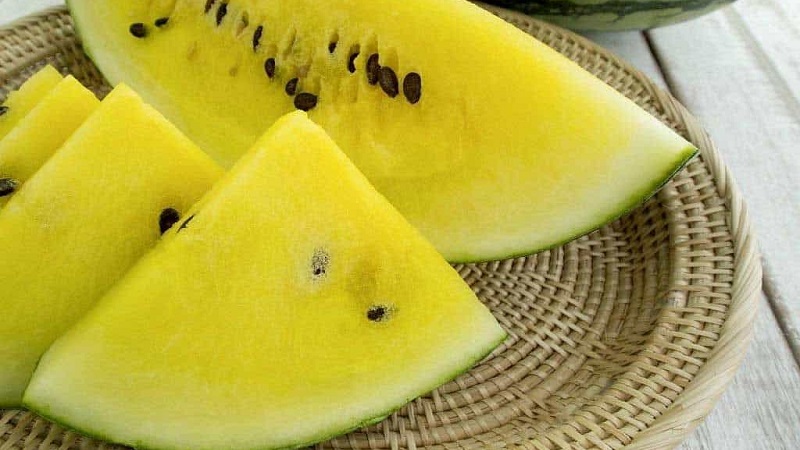
Many people assume that the progenitor of the yellow variety is a watermelon crossed with a melon, but this is not the case. Such the breeders managed to achieve an unusual shade of pulp by crossing cultivated red watermelon with wild African.
It is interesting. The ancestor of modern watermelons is completely different from the berries we are used to. Its fruits were small, had yellow flesh and were either tasteless or piercingly bitter.
Yellow watermelons are high in sugar and therefore sweeter than red ones... Some varieties contain 10-12% sugar, which is why they taste honey.
Differences between red and yellow watermelons
The main distinguishing feature of yellow watermelons is the color of their flesh.... But besides him, they have a number of characteristic features that are not present in the varieties we are used to.
It is interesting. Yellow watermelon has become very popular in Thailand, because according to Thai tradition, the golden color attracts money.
These berries are much smaller than the red ones.... They rarely weigh more than 7 kg. For some varieties of red watermelons (for example, Chill), the weight of 10-13 kg is not the limit.
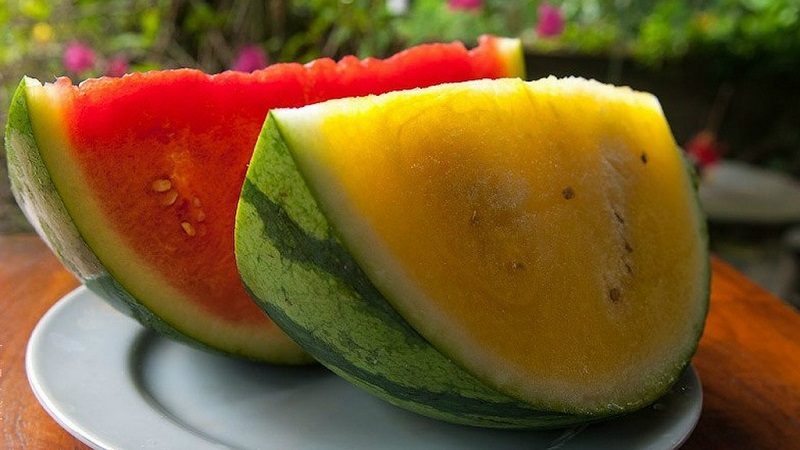
The flavor variety in yellow watermelons is much wider than that of red ones.... Different varieties can have peach, pumpkin, pineapple and even mango flavors. Also, the sugar content varies in different varieties, so they differ in sweetness. At the same time, there are much less yellow varieties than red ones.
Another sign valuable for amateurs is few seeds in yellow watermelons... In some varieties, they are not at all.
Interesting on the site:
Properties and composition of yellow watermelons
100 g of the pulp of this berry contains:
- calories - 38 kcal;
- proteins - 0.6 g;
- fat - 0.1 g;
- carbohydrates - 6.2 g;
- ash - 0.4 g;
- fiber - 0.4 g;
- water - 92.3 g.
Many mistakenly believe that watermelons are composed exclusively of water and sugar... But this is not the case. Despite the fact that the pulp is actually as much as 92% water, it contains many substances that are important for the normal functioning of our body.
Vitamins:
 PP - 0.2 mg;
PP - 0.2 mg;- E - 0.1 mg;
- C - 7 mg;
- B9 - 8 mcg;
- B6 - 0.09 mg;
- B5 - 0.2 mg;
- B2 - 0.06 mg;
- B1 - 0.04 mg;
- A - 17 μg;
- beta-carotene - 0.1 mg;
- B3, PP - 0.3 mg;
Macro- and microelements:
- phosphorus - 14 mg;
- potassium - 110 mg;
- sodium - 16 mg;
- magnesium - 12 mg;
- calcium - 14 mg.
- iron - 1 mg.
Beneficial features
Vitamin A good for the eyes. It helps prevent vision problems.
Ascorbic acid, or vitamin C, improves immunity and helps protect the body from infections.
Calcium strengthens bones and nails, makes hair shiny and beautiful.
Iron, magnesium and potassium improve blood function and increase vascular strength, which is important for people suffering from anemia and anemia.
Fiber in the pulp improves the activity of the digestive system, promotes better digestion of food. It also removes toxins and excess fluid.
Yellow watermelon is free of fat and cholesterol, thanks to which this product is not dangerous for blood vessels. Therefore, people suffering from atherosclerosis and high cholesterol levels can use it without fear.
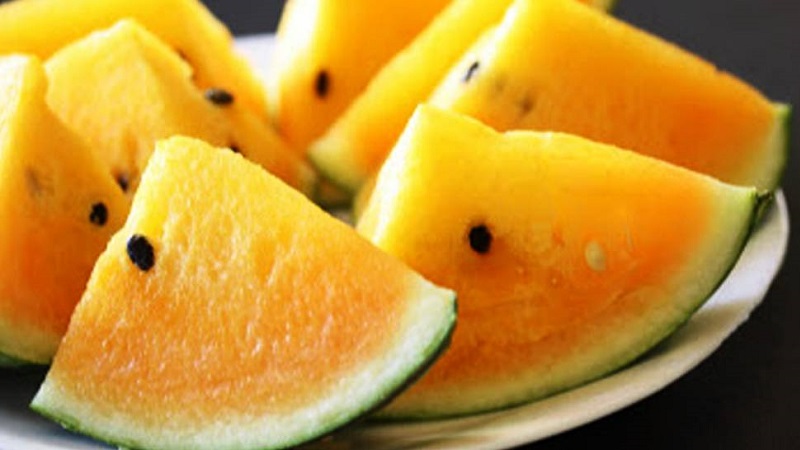
Low-calorie and water-rich pulp perfect for those who sit on a diet... It satisfies appetite well and has a diuretic effect.
Important! You cannot stick to the watermelon mono-diet for more than two days. To achieve the desired effect, nutritionists advise to repeat it regularly, taking breaks of 4-5 days.
Folic acid is involved in protein synthesis, performs a hematopoietic function, improves the functioning of the nervous system. It is especially beneficial for the female body.
Contraindications
The benefits of yellow watermelons are undeniable, but, unfortunately, they also have contraindications.... There are a number of diseases in which its use is undesirable or completely prohibited:
- The irrepressible consumption of yellow berries is fraught with intestinal problems.
- The glycemic index of watermelon is very high - 72. It contains a number of easily digestible sugars (glucose, sucrose, fructose), so diabetic patients are not recommended to use it.
- Due to the large amount of water, watermelon can harm people with kidney disease as it puts more stress on them.
- Some components of watermelon can provoke an allergic reaction, which manifests itself some time after consumption. This pause is due to the substances taking time to digest. The most common manifestations of allergies are rhinitis, pain and sore throat, difficulty breathing (including the risk of Quincke's edema), redness of the eyes, watery eyes, rashes, itching, swelling of mucous membranes and soft tissues, pain in the abdomen, bloating, spasms and pain, nausea and diarrhea.
If you find these symptoms in yourself, you should stop drinking watermelon., it is advisable to consult an allergist.

Most popular varieties
Yellow watermelon appeared relatively recently on the world market., but even now there are many varieties of this berry. These can be purchased at gardening stores. Yellow watermelons, along with red ones, are successfully grown on melons by amateur gardeners both in Russia and abroad:
- Lunar F1... This is the most famous and popular type of yellow watermelon in Russia. It has won recognition for its cold hardiness. This hybrid can easily withstand minor cold snaps. The approximate ripening time is 70-75 days. Lunar has a bright yellow, juicy pulp. Its characteristic feature is a pronounced mango flavor.
- Golden Grace F1... The homeland of this hybrid is Holland. It belongs to the mid-season, the approximate ripening period is 75–82 days. Like Lunny, he calmly endures frosts. The fruits are quite large, can reach 8 kg. Golden Grace's flesh is yellow, sugary, and the seeds, even when ripe, remain soft and translucent.
- Yellow dragon... This is an early ripening variety, with an approximate ripening period of 60–65 days. Fruits are medium in size, their weight usually does not exceed 4–6 kg. Their shape is slightly elongated, the shade of the skin is dark. The flesh of the Yellow Dragon has a yellow-orange color and honey flavor.
- Prince Hamlet F1... This hybrid was developed in Russia. It also belongs to the early maturing - it takes no more than 70 days for the fruit to ripen. Its fruits are round in shape and weigh about 2 kg. The peel is thin, light green, with a dark strip. The pulp is lemon yellow and sweet. It tastes a bit like pineapple.
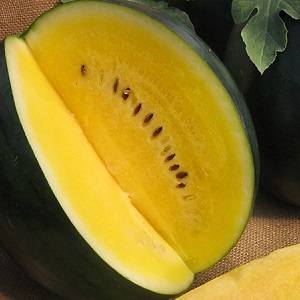 Yanosik (on the picture). It is a mid-season variety that ripens in about 75–80 days. Its fruits are slightly elongated, their weight usually does not exceed 3–6 kg. Yanosik's rind is bright green, the stripes on it are almost invisible. The pulp is juicy, its taste is honey, with few seeds. Watermelon of this variety is suitable for long-term storage, and at the same time it does not lose its taste.
Yanosik (on the picture). It is a mid-season variety that ripens in about 75–80 days. Its fruits are slightly elongated, their weight usually does not exceed 3–6 kg. Yanosik's rind is bright green, the stripes on it are almost invisible. The pulp is juicy, its taste is honey, with few seeds. Watermelon of this variety is suitable for long-term storage, and at the same time it does not lose its taste.- Imbar F1... This hybrid was bred in Israel. It belongs to the early maturing - the harvest can be obtained in 50–55 days. The fruits of this watermelon are round, their average weight is 4–7 kg. The peel is dark green in color, with a glossy sheen. The flesh of Imbar is orange in color, crispy and sweet, pitted.
- Primagold F1... This is a very early hybrid, which needs only 40–45 days to mature. Moreover, its fruits are by no means small - their weight is about 4 kg. Primagold berries are round, the skin is green, with thin dark stripes. The pulp is bright yellow, crispy and sweet (10-12% sugar), there are few seeds in it.
- Peach... The homeland of this variety is the USA. It belongs to mid-season, ripening time is about 90 days. The fruits are rather large, average weight is about 5-6 kg, elongated shape. Peach's flesh is orange, with a pinkish tinge, has a delicate taste with peach notes.
- Yellow dollars... This variety was bred in Thailand and belongs to the mid-season. Ripening time - 68–70 days. Fruits weigh 3 kg on average, their shape is slightly elongated. The rind is light green with thin dark stripes. The pulp is bright yellow, with a strong honey flavor, it contains small seeds. The main feature of the variety is its thin and edible rind.
- Kavbuz F1... Breeders from Ukraine have developed an unusual hybrid of a yellow watermelon that tastes like a pumpkin. Feature - it is not consumed raw.
Choosing a yellow watermelon
Yellow watermelons ripen before red ones, therefore, appear on sale at the beginning of summer. They are quite often imported from hot countries, where they ripen much earlier than July-August.
Reference.Yellow watermelon is not a cheap delicacy: the cost of such berries is about 2-3 times higher than that of their red counterparts.
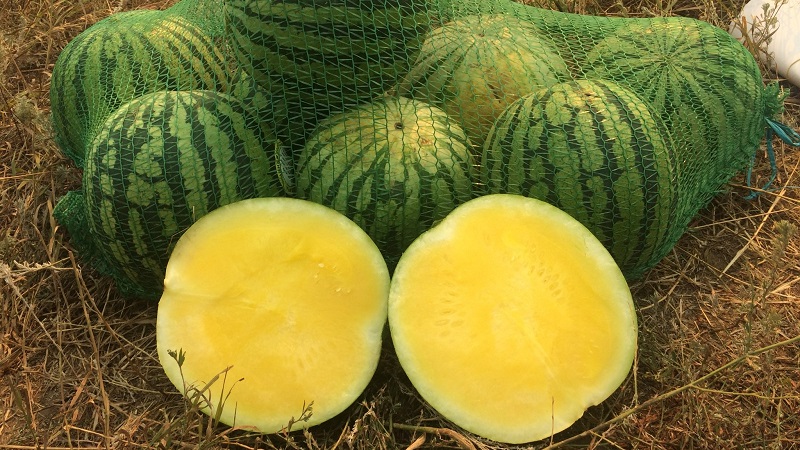
Choosing a yellow watermelon is pretty easy... His signs of ripeness are about the same as those of red. Pay attention to the size and weight of the berry - it should not exceed 2–6 kg. Also an indicator is the glossy shine of the peel, a dull sound when tapped and a quiet crunch when squeezed, a yellow melon spot and a dry, yellow tail.
Important! Watermelons don't ripen after being harvested.
When choosing, it is worth checking that there are no mechanical damages on the fetus... Through cracks and scratches, harmful substances from the air (eg exhaust fumes), mold and disease-causing bacteria penetrate into the pulp. If the berry is damaged while still on the melon, there is a risk that pesticides have got into it, with which the beds are treated to fight insects.
Yellowness in the pulp of red watermelons
Often in a regular green berry, the flesh can be yellowish or orange. Most often, a watermelon with a yellow inside indicates that it is immature. or contains an unacceptable amount of nitrates.
To increase yields and accelerate plant growth, unscrupulous gardeners flood the fields with nitrogen fertilizers, the elements of which accumulate in the fruits. Once in the human body, they can cause severe poisoning.
Sometimes on the shelves there are watermelons with an unusual yellow rind. This is by no means a sign of an abundance of nitrates. Most likely, this is a rare variety of yellow watermelon with red pulp.
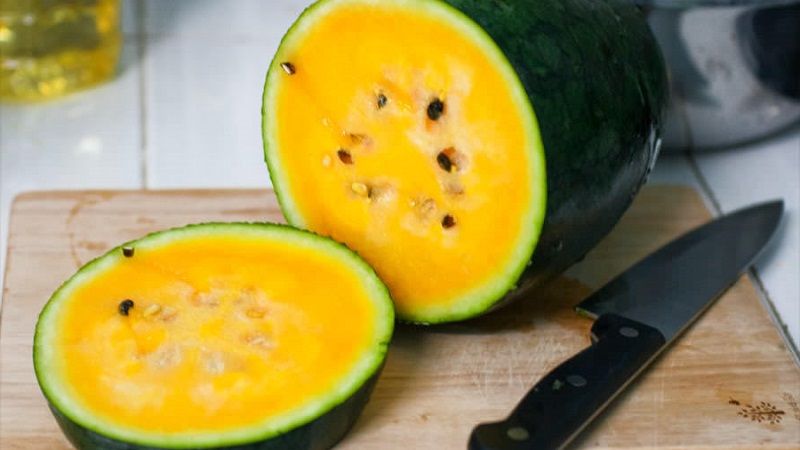
Signs of nitrate watermelon
It is not recommended to choose large fruits... This means that the plant is oversaturated with fertilizers. If in doubt, it is worth asking the seller for the conclusion of the SES (sanitary and epidemiological service). Products on sale must be tested.
After purchasing, carefully examine the pulp. If it is whitish or yellow or white streaks (less often - light spots), as well as cavities, then nitrite content in the berry is definitely exceeded. Another sign of nitrate is pale and small bones. They should be brown in ripe berries.
If the watermelon is yellowish inside, this may also mean that it is simply not ripe.... In this case, you cannot eat it, since unripe fruits can provoke an eating disorder. It is not worth leaving such a watermelon in the hope that it will "come". These berries can only ripen on melons.
Conclusion
Yellow watermelon is not only an interesting and exotic delicacy, but also a healthy product. Its sweet taste will delight both children and adults, and the juicy pulp will perfectly quench your thirst in the summer heat. But at the same time, one should not forget about contraindications and moderation in the use of this berry in order to avoid possible unpleasant consequences.
The correct choice of yellow watermelon and adherence to simple nutritional rules will allow you to get maximum pleasure and reveal all the benefits of this wonderful product.